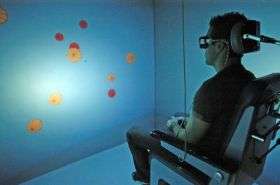New Virtual Tool Can Train Athlete Brains to React 53 Percent Faster, Improve Their Game

All great athletes know that in order to perform well, they can't just depend on their physical capabilities. Speed and efficiency in decision-making are just as essential. Two researchers from the School of Optometry of the Université de Montréal have discovered how to train the brain of athletes to improve their overall athletic performance.
Professor Jocelyn Faubert and postdoctoral student David Tinjust, put a dozen soccer, tennis and hockey players through multiple object-tracking exercises. The athletes' capacity to absorb a lot of information simultaneously and manage it efficiently increased on average by 53 percent.
In one of these exercises, subjects in the automatic virtual environment cave were asked to follow the increasingly rapid movements of a series of balls and identify those that quickly changed colour. After each training session, which lasted about an hour, results were recorded and athletes could note their progress. "It's like physical training, but for the brain," says Faubert.
The approach has already gained great popularity among athletes, from star goalie Kim St-Pierre to North American boxing champion Anthonin Décarie.
"In their normal workouts, athletes regularly evaluate their physical performance, but until now there has been no tool that could rate their cognitive performance," says Faubert. "If an athlete feels both physically and mentally ready, that can only have a positive influence on his or her performance."
Originally, the tool was used to see how elderly people or those with vision problems would behave in a virtual environment. For example, how could subjects work their way through a crowd, traffic or get on an escalator? The researchers then decided to adapt the process to top athletes and transfer the scientific knowledge to virtual training tools.
Athletes could wear a virtual helmet that would allow them to train anywhere. They could also wear cybernetic gloves and glasses and, while viewing superimposed images, they could practise complex movements with a fictitious opponent. Every movement of the hand, foot and head would be recorded with sensors.
Source: University of Montreal




















